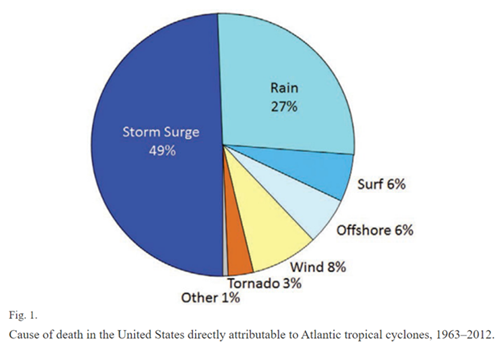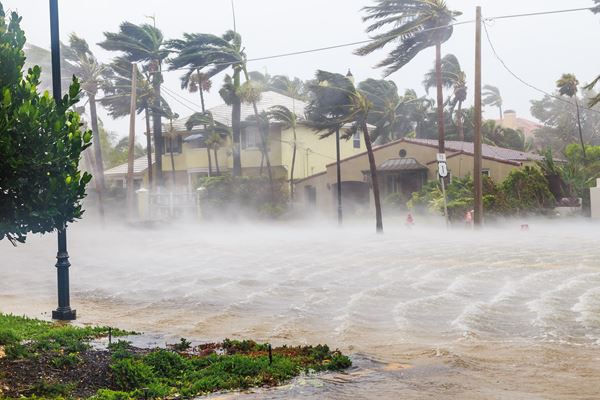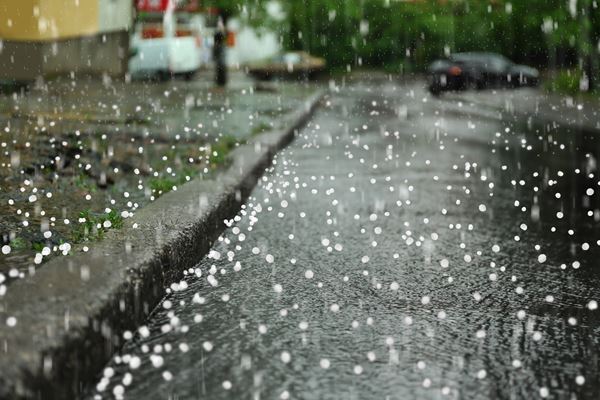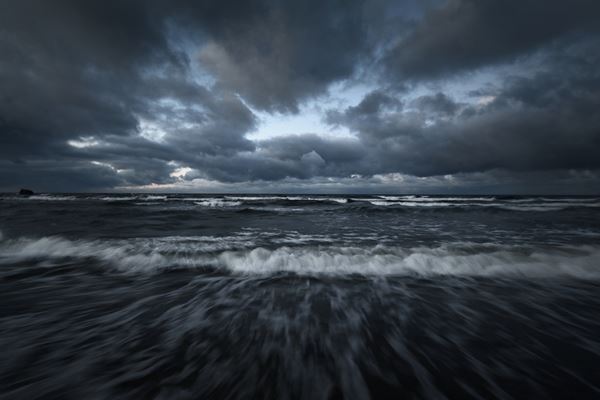Hurricane Ratings and Storm Surge Explained
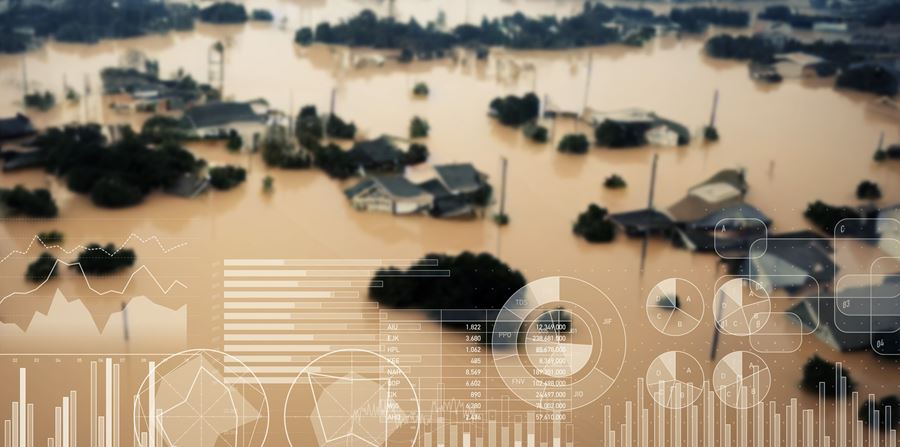
In our last article, 3 Facts You Need To Know About Hurricanes, we talked about the basics of hurricanes, how they form, what makes them different from other tropical systems, and when they are most likely to occur.
There are many different reasons how and why hurricanes cause damage and hurricanes can vary greatly in their strength and the dangers they pose. In this installment, we’ll cover how hurricane strength is determined while explaining one of the most dangerous hazards from any hurricane: storm surge.
While many may be familiar with the categories of hurricanes, ranking hurricane strength is a relatively recent development. The metrics and processes behind these rankings are barely 50 years old and have changed multiple times since their inception.
The scale used to rate hurricanes is called the Saffir-Simpson Scale and was designed in 1971, and then rolled out to the public in 1973. It was developed by Herbert Saffir, a structural engineer, who gave it to the National Hurricane Center (NHC) where it was further developed by meteorologist Robert Simpson. While Simpson was responsible for adding flooding and storm surge effects to the scale, these were eliminated in 2009. The current scale rates hurricanes in categories from 1-5 (5 being the strongest). These ratings are now determined by wind speed alone, with category parameters being tweaked as recently as 2012.
Hurricane Categories and Wind Speeds
Below is the breakdown of each category as determined by the NHC1. Note that “sustained winds” are the average wind speed as measured from a height of 33 feet over one minute.
Category 1
Sustained Winds: 74-95 mph, 64-82 kt, 119-153 km/h
Types of Damage Due to Hurricane Winds: Very dangerous winds will produce some damage.
Well-constructed frame homes could have damage to roof, shingles, vinyl siding and gutters. Large branches of trees will snap and shallowly rooted trees may be toppled. Extensive damage to power lines and poles likely will result in power outages that could last a few to several days.
Category 2
Sustained Winds: 96-110 mph, 83-95 kt, 154-177 km/h
Types of Damage Due to Hurricane Winds: Extremely dangerous winds will cause extensive damage.
Well-constructed frame homes could sustain major roof and siding damage. Many shallowly rooted trees will be snapped or uprooted and block numerous roads. Near-total power loss is expected with outages that could last from several days to weeks.
Category 3 (major)
Sustained Winds: 111-129 mph, 96-112 kt, 178-208 km/h
Types of Damage Due to Hurricane Winds: Devastating damage will occur.
Well-built framed homes may incur major damage or removal of roof decking and gable ends. Many trees will be snapped or uprooted, blocking numerous roads. Electricity and water will be unavailable for several days to weeks after the storm passes.
Category 4 (major)
Sustained Winds: 130-156 mph, 113-136 kt, 209-251 km/h
Types of Damage Due to Hurricane Winds: Catastrophic damage will occur.
Well-built framed homes can sustain severe damage with loss of most of the roof structure and/or some exterior walls. Most trees will be snapped or uprooted and power poles downed. Fallen trees and power poles will isolate residential areas. Power outages will last weeks to possibly months. Most of the area will be uninhabitable for weeks or months.
Category 5 (major)
Sustained Winds: 157 mph or higher137 kt or higher 252 km/h or higher
Types of Damage Due to Hurricane Winds: Catastrophic damage will occur.
A high percentage of framed homes will be destroyed, with total roof failure and wall collapse. Fallen trees and power poles will isolate residential areas. Power outages will last for weeks to possibly months. Most of the area will be uninhabitable for weeks or months. (Source: 1)
While the Saffir-Simpson Scale is an effective tool to help determine hurricane strength, it is a flawed scale. This is because it rates hurricanes by wind speed alone and does not consider the severity of other hazards like tornadoes, rainfall, flooding, and storm surge. Water alone accounts for more than 75% of the deaths in hurricanes that hit the United States, and the most dangerous water hazard is storm surge.
(Source: 2)
The Importance of Storm Surge Protection
Storm surge accompanies every tropical system upon landfall. It is defined by the NHC as an abnormal rise of water generated by a storm, over and above the predicted astronomical tide. It is a powerful tsunami-like phenomenon that can cause widespread destruction of property and loss of life. While the low-pressure center of the storm and the Coriolis Effect can contribute to surge levels, the main factor in creating surge is wind. The damage it can cause is determined by the depth and topography of the ocean and the coast upon landfall.
When a hurricane is still far offshore, the associated winds will drive water into a vertical circulation in the ocean, with some of that water being driven downward. In deep water, this isn’t as evident, as there is little to disturb this circulation. However, as the storm approaches shallower water, this circulation is disrupted by the ocean floor. The water can no longer go down, is forced upward, and eventually toward the coast and inland as the hurricane makes landfall.
What is Storm Surge
Storm surge is much different than waves. Hurricanes move quite slowly in contrast to the windspeeds contained therein and landfall of a hurricane can last hours. During this time, hurricane-force winds are constantly driving water inland, with the biggest surge danger generally being in the right front section of the eyewall, the region within a hurricane that contains the strongest winds combined with the forward movement of the storm itself. However, coastal topography can vary and influence surge. Some coastal areas don’t rise as much as others, meaning that surge levels can vary due to the slope of the continental shelf. A shallow continental shelf will produce a higher surge than one that is steep.
All this water can cause catastrophic damage and is often the number one cause of death in a hurricane. Unfortunately, surge is not included as part of the Saffir-Simpson Scale, which can lead to discrepancies in ratings versus actual effects. For example, Hurricane Florence in 2018 was a Category 1 storm but produced a record-breaking storm surge in North Carolina. The highest storm surge recorded in the US accompanied Hurricane Katrina in 2005. When combined with wave heights, the surge level topped 30 feet in parts of coastal Mississippi. It only takes two feet of water to carry away most vehicles.
Properties Most at Risk
Although surge is most dangerous along the coastline, it can be pushed miles inward, and those who reside further from the coast can also find themselves and their property at risk. Water levels are also amplified by the torrential rain that accompanies hurricanes, as inland runoff combines with surge in bays, river mouths, coastal estuaries, canals, and wetlands. Storm surge from Hurricane Katrina reached more than 10 miles inland in parts of coastal Mississippi.
Regardless of category, those who live in hurricane-prone areas should heed all warnings if a hurricane is forecast and have a plan in place long before a hurricane forms. During a hurricane, water can rise very quickly, sometimes several feet within minutes. Those residing in areas prone to flooding and surge should be prepared to evacuate if an order is given and not wait until landfall is imminent. Once the storm is impacting the coast, emergency responders are also constrained by the hazardous conditions and often cannot render assistance until the danger has passed.
1. National Hurricane Center www.nhc.noaa.gov
2. Rappaport, Edward N. “Fatalities in the United States from Atlantic Tropical Cyclones: New Data and Interpretation”. Bulletin of the American Meteorological Society, vol. 95, issue 3, 2014, pp 341-346. https://journals.ametsoc.org/view/journals/bams/95/3/bams-d-12-00074.1.xml. Published 2014 by the American Meteorological Society.
Vores eksperter kan hjælpe dig!

